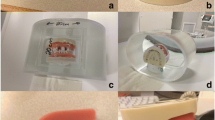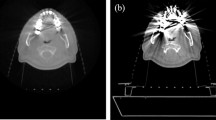Abstract
Introduction
Metal artifacts may negatively affect radiologic assessment in the oral cavity. The aim of this study was to evaluate different metal artifact reduction techniques for metal artifacts induced by dental hardware in CT scans of the oral cavity.
Methods
Clinical image quality was assessed using a Thiel-embalmed cadaver. A Catphan phantom and a polymethylmethacrylate (PMMA) phantom were used to evaluate physical-technical image quality parameters such as artifact area, artifact index (AI), and contrast detail (IQFinv). Metal cylinders were inserted in each phantom to create metal artifacts. CT images of both phantoms and the Thiel-embalmed cadaver were acquired on a multislice CT scanner using 80, 100, 120, and 140 kVp; model-based iterative reconstruction (Veo); and synthesized monochromatic keV images with and without metal artifact reduction software (MARs). Four radiologists assessed the clinical image quality, using an image criteria score (ICS).
Results
Significant influence of increasing kVp and the use of Veo was found on clinical image quality (p = 0.007 and p = 0.014, respectively). Application of MARs resulted in a smaller artifact area (p < 0.05). However, MARs reconstructed images resulted in lower ICS.
Conclusion
Of all investigated techniques, Veo shows to be most promising, with a significant improvement of both the clinical and physical-technical image quality without adversely affecting contrast detail. MARs reconstruction in CT images of the oral cavity to reduce dental hardware metallic artifacts is not sufficient and may even adversely influence the image quality.









Similar content being viewed by others
References
Geets X et al (2005) Inter-observer variability in the delineation of pharyngo-laryngeal tumor, parotid glands and cervical spinal cord: comparison between CT-scan and MRI. Radiother Oncol 77(1):25–31
Barrett JF, Keat N (2004) Artifacts in CT: recognition and avoidance. Radiographics 24(6):1679–1691
Lee MJ et al (2007) Overcoming artifacts from metallic orthopedic implants at high-field-strength MR imaging and multidetector CT. Radiographics 27(3):791–803
Fiala TGS, Novelline RA, Yaremchuk MJ (1993) Comparison of Ct imaging artifacts from craniomaxillofacial internal-fixation devices. Plast Reconstr Surg 92(7):1227–1232
Haramati N et al (1994) Ct scans through metal scanning technique versus hardware composition. Comput Med Imaging Graph 18(6):429–434
Moon SG et al (2008) Metal artifact reduction by the alteration of technical factors in multidetector computed tomography: a 3-Dimensional quantitative assessment. J Comput Assist Tomogr 32(4):630–633
Lee IS et al (2007) A pragmatic protocol for reduction in the metal artifact and radiation dose in multislice computed tomography of the spine: cadaveric evaluation after cervical pedicle screw placement. J Comput Assist Tomogr 31(4):635–641
Habets J et al (2012) Artifact reduction strategies for prosthetic heart valve CT imaging. Int J Cardiovasc Imaging 28(8):2099–2108
Stradiotti P et al (2009) Metal-related artifacts in instrumented spine. Techniques for reducing artifacts in CT and MRI: state of the art. Eur Spine J 18:S102–S108
Link TM et al (2000) CT of metal implants: reduction of artifacts using an extended CT scale technique. J Comput Assist Tomogr 24(1):165–172
Funama Y et al (2015) A newly-developed metal artifact reduction algorithm improves the visibility of oral cavity lesions on 320-MDCT volume scans. Physica Med-Eur J Med Phys 31(1):66–71
Zhang D, Li XH, Liu B (2011) Objective characterization of GE Discovery CT750 HD scanner: gemstone spectral imaging mode. Med Phys 38(3):1178–1188
Lee YH et al (2012) Metal artefact reduction in gemstone spectral imaging dual-energy CT with and without metal artefact reduction software. Eur Radiol 22(6):1331–1340
Wang Y et al (2013) Metal artifacts reduction using monochromatic images from spectral CT: evaluation of pedicle screws in patients with scoliosis. Eur J Radiol 82(8):E360–E366
Lewis M, Reid K, Toms AP (2013) Reducing the effects of metal artefact using high keV monoenergetic reconstruction of dual energy CT (DECT) in hip replacements. Skelet Radiol 42(2):275–282
Thiel W (2002) Ergänzung für die Konservierung ganze Leichen nach W. Thiel Annals Anat 184:267–269
Thiel W (1992) Die Konservierung ganzer Leichen in natürlichen Farben. Ann Anat 174:185–195
Lin XZ et al (2011) High-definition CT gemstone spectral imaging of the brain: initial results of selecting optimal monochromatic image for beam-hardening artifacts and image noise reduction. J Comput Assist Tomogr 35(2):294–297
van der Schaaf I et al (2006) Minimizing clip artifacts in multi CT angiography of clipped patients. Am J Neuroradiol 27(1):60–66
Thijssen M, Bijkerk K, van der Burgth R (1998) Manual contrast-detail phantom CDRAD type 2.0. Project quality assurance in radiology. Department of Radiology, University Hospital Nijmegen, St. Radboud, The Netherlands
AAPM report no.39 (1993) Specification and acceptance testing of computed tomography scanners. AAPM
Samei E et al (2005) Assessment of display performance for medical imaging systems: executive summary of AAPM TG18 report. Med Phys 32(4):1205–1225
Viner M et al (2013) Liver SULmean at FDG PET/CT: interreader agreement and impact of placement of volume of interest. Radiology 267(2):596–601
Vogel L et al (2009) Intra-rater agreement of the anorectal exam and classification of injury severity in children with spinal cord injury. Spinal Cord 47(9):687–691
Maroldi R et al (1996) Computed tomography scanning of supraglottic neoplasms: its cost effective use in preoperative staging. Acad Radiol 3:S57–S59
Chindasombatjaroen J et al (2011) Quantitative analysis of metallic artifacts caused by dental metals: comparison of cone-beam and multi-detector row CT scanners. Oral Radiol 27(2):114–120
Boas FE, Fleischmann D (2011) Evaluation of two iterative techniques for reducing metal artifacts in computed tomography. Radiology 259(3):894–902
Kondo A et al (2010) Iterative correction applied to streak artifact reduction in an X-ray computed tomography image of the dento-alveolar region. Oral Radiol 26(1):61–65
Dong J et al (2013) Metal-induced streak artifact reduction using iterative reconstruction algorithms in x-ray computed tomography image of the dentoalveolar region. Oral Surg Oral Med Oral Pathol Oral Radiol 115(2):E63–E73
Zhou CS et al (2011) Monoenergetic imaging of dual-energy CT reduces artifacts from implanted metal orthopedic devices in patients with factures. Acad Radiol 18(10):1252–1257
Bamberg F et al (2011) Metal artifact reduction by dual energy computed tomography using monoenergetic extrapolation. Eur Radiol 21(7):1424–1429
Wang FD et al (2014) Reduction of metal artifacts from alloy hip prostheses in computer tomography. J Comput Assist Tomogr 38(6):828–833
Brook OR et al (2012) Spectral CT with metal artifacts reduction software for improvement of tumor visibility in the vicinity of gold fiducial markers. Radiology 263(3):696–705
Pessis E et al (2013) Virtual monochromatic spectral imaging with fast kilovoltage switching: reduction of metal artifacts at CT. Radiographics 33(2):573–583
Ethical Standards and Patient Consent
We declare that all human and animal studies have been approved by the Ethics Committee of Ghent University, B67020095736, and have therefore been performed in accordance with the ethical standards laid down in the 1964 Declaration of Helsinki and its later amendments. The Thiel body was obtained from the Department of Anatomy of Ghent University. The patient willingly donated their body to science.
Conflict of interest
We declare that we have no conflict of interest.
Author information
Authors and Affiliations
Corresponding author
Rights and permissions
About this article
Cite this article
De Crop, A., Casselman, J., Van Hoof, T. et al. Analysis of metal artifact reduction tools for dental hardware in CT scans of the oral cavity: kVp, iterative reconstruction, dual-energy CT, metal artifact reduction software: does it make a difference?. Neuroradiology 57, 841–849 (2015). https://doi.org/10.1007/s00234-015-1537-1
Received:
Accepted:
Published:
Issue Date:
DOI: https://doi.org/10.1007/s00234-015-1537-1




